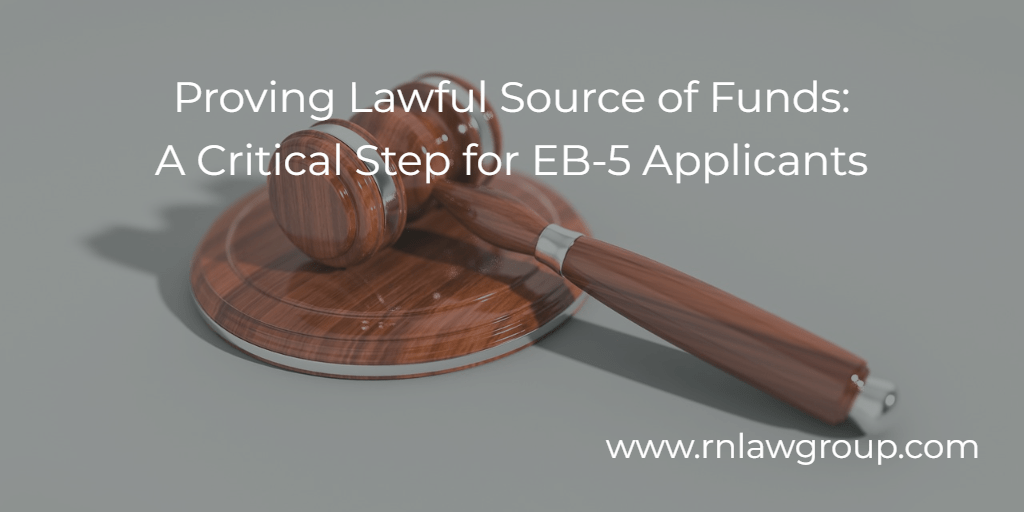
Proving Lawful Source of Funds: A Critical Step for EB-5 Applicants
The EB-5 visa program offers foreign investors and their families a path to U.S. residency through job-creating investments in the United States. The current investment amount for the EB-5 program is $800,000 to $1,050,000 depending on whether you are investing in a targeted employment area or not. However, merely having the funds in your account and ready to invest is not enough EB-5. One of the most important parts of an EB-5 application is the requirement that applicants must prove their investment funds come from legitimate and lawful sources.
Documenting “source of funds” is a critical requirement and a common challenge for EB-5 visa applicants. U.S. Citizenship and Immigration Services (USCIS) scrutinizes the paper trail to ensure funds originate from lawful business, investment, gift, inheritance, or other legitimate activities. Simply showing accumulation of funds in a bank account is insufficient – the full sequence tracing money from its origin to the EB-5 investment must be demonstrated. The EB-5 I-526 petition requires extensive documentation of the source of the investment funds and tracing the funds back, more or less, to their origin.
Why Source of Funds Matter
Documenting lawful source of funds serves multiple important purposes. First, it shows the government that the applicant’s funds do not originate from illegal activities like money laundering, tax evasion, corruption, or other crimes – which could disqualify the investor from U.S. residency. If the funds come from an illegal source that could lead to a finding of inadmissibility, USCIS would not approve the EB-5.
Second, the source of funds audit trail allows USCIS to ensure there are not attempt to fraudulently “pump up” an investor’s net worth. USCIS needs to verify funds are genuinely owned and controlled by the investor.
Finally, tracing funds back to their origin and forward to the EB-5 investment provides assurance the money legally belongs to the investor. Funds cannot be tied up in loans, subject to liens or claims, held in unofficial accounts like pension funds, or derived from other questionable sources.
Meeting the “Preponderance of Evidence” Standard
USCIS holds EB-5 applicants to a “preponderance of evidence standard,” and it is no different for source of funds documentation. This means the presented evidence must demonstrate it is more likely than not that the investment funds originate from legal sources claimed by the investor.
With this threshold, even if USCIS cannot state with 100% certainty the legitimacy of presented documents, the applicant still meets the lawful source of funds requirement if the overall weight of evidence tips in their favor.
No Time Limit on Tracing EB-5 Funds
USCIS often pushes EB-5 applicants to trace funds back decades, even over 30 years in some cases. There is no defined statute of limitations on how far back documentation must reach. In fact, there have been reports from attorneys that USCIS has wanted documentation going back to times where documentation for that individual’s country may have been destroyed by war or other disasters.
Generally speaking the following are good guidelines to follow for how far back to trace funds:
– Transactions within 5 years require direct documentary evidence like tax returns, employer letters, etc.
– Transactions beyond 5 years can rely more on indirect evidence like pension records, affidavits, etc.
In practice, USCIS adjudicators tend to probe further back in time if the initial filing documentation of the money trails contain gaps or inconsistencies. Applicants who can show a long, unbroken chain of evidence from origin to present day often avoid extensive retrospective documentation requirements.
Navigating Complex EB-5 Source of Funds Histories
Many EB-5 investors have accumulated wealth gradually over long time periods and may have changed careers, employers, and even non-EB-5 investments multiple times over the years. Their personal source of funds story may contain layers of complexity from decades of transactions across institutions, borders, currencies, and asset classes.
Reconstructing this intricate sequence of events long after the fact poses a major challenge. Applicants often struggle to retrieve reliable records from far-flung global sources going back 10, 20, or even 30 years. Even with documents in hand, the endless permutations of possible money flows overwhelm attempts to assemble into coherent narratives.
Fortunately, most complex source of funds puzzles can be solved with patience and a systematic approach. By single-mindedly working evidence trails in reverse chronological order, the fog generally starts to clear. An experienced EB-5 attorney can provide invaluable assistance making sense of convoluted financial histories. Their expertise tracing funds across diverse geographic and commercial landscapes helps establish compliance.
Key EB-5 Source of Funds Categories
USCIS recognizes and regularly encounters certain standard categories of EB-5 source of funds. While individual cases have unique aspects, some typical sources and expected documentation include:
Real Estate Sales: Title deeds, sales/transfer agreements, tax documentation, appraisals, bank records demonstrating deposit of proceeds. Need to able to show that the property was lawfully owned and sold.
Salaries: Tax returns, employer letters, pay stubs, bank records showing deposit of earnings. Employment cannot be in an unlawful endeavor. While this is not likely common, some employment is allowed in some countries or even states that are not federally lawful, for example, working at a marijuana dispensary.
Business Income: Registration documents, financial statements demonstrating sufficient earnings to distribute, bank records showing transferred funds.
Gifts: Declarations of gift, source of funds records for gift giver. There must be proof that the source of funds from the gift giver is lawful.
Inheritances: Wills, court documentation, attorney affidavits, death certificates, bank records.
Loan: Proof that the loan is NOT secured by the assets of the EB-5 project, that the investor is primarily responsible for the loan, and that the loan is legitimate and the party issuing the loan can be verified. Loans do not have to be secured loans.
Assembling a Complete EB-5 Petition
While intimidating at first, most investors can assemble satisfactory source of funds documentation by working methodically back in time through previous transactions. Keeping and reviewing detailed records will be key for the EB-5 source of funds. Experienced EB-5 immigration attorneys can provide invaluable guidance on common pitfalls and help applicants gather hard-to-locate historical records.
Paying close attention to source of funds documentation makes the difference between a smooth EB-5 application process and lengthy delays or even denial due to questions surrounding the investor’s funds. Given the long-term life changes hinging on EB-5 approval, investors should devote adequate time and resources to proving source of funds right from the start.
Reddy Neumann Brown PC, located in Houston, Texas, has been serving the business community for over 25 years and is Houston’s largest immigration law firm focused solely on U.S. Employment-based immigration. We work with both employers and their employees, helping them navigate the immigration process quickly and cost-effectively.
By: Steven Brown
Steven Brown is a Partner at Reddy Neumann Brown PC where he works in the Non-immigrant visa department and leads the Litigation Team. His practice covers all phases of the non-immigration visa process including filing H-1B, L-1, E-3, H-4, and H-4 EAD petitions. In the last two years, Steven has successfully handled over 1,000 non-immigrant visa petitions including filing petitions, responding to any necessary Requests for Evidence, and drafting motions and appeals. He has also become a key resource for F-1 students that seek guidance on properly complying with the F-1 visa regulations and any OPT or CPT issues they may have. Additionally, Steven holds a weekly conference call for companies that are part of one of the largest organizations for IT Services companies in America.

